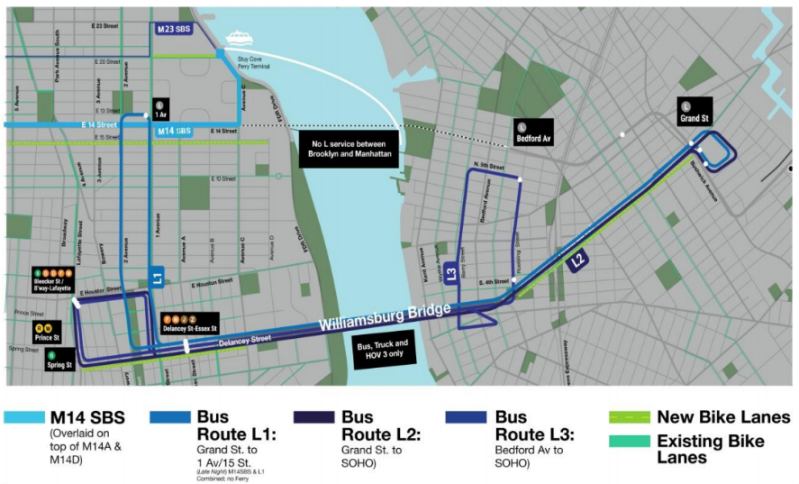Skittish DOT Won’t Commit to 24/7 Bus Lanes During L Train Outage
DOT has a plan to help out transit riders with a network of bus lanes while the L train is out of commission for 15 months, but the agency won't commit to prioritizing buses throughout the day.

DOT has a plan to help out transit riders with a network of bus lanes while the L train is out of commission for 15 months, but the agency won’t commit to prioritizing buses throughout the day.
The proposed busway on 14th Street will only be in effect during “peak hours,” DOT Commissioner Polly Trottenberg said at a City Council hearing today. It’s not clear exactly what times of day that would cover, but changing the rules throughout the day is a recipe for confusion and gridlock.
Representatives from DOT and the MTA answered questions from council members following the Wednesday release of a draft plan to manage the L shutdown.
DOT is planning for a transit- and deliveries-only 14th Street between Third Avenue and Eighth Avenue in the westbound direction and between Ninth Avenue and Third Avenue eastbound. (The agency thinks a full river-to-river busway would cause too much traffic on the edges of the island.)
In addition, the Williamsburg Bridge, which will carry as many as 70 buses during peak hours, will be restricted to buses, trucks, and motor vehicles with three or more occupants. And frequent shuttle bus service between North Brooklyn and Manhattan would have bus lanes on important street segments.
In all cases, DOT has not made clear when transit priority will be in effect. But the agency is clearly hesitant to say buses will come first at all times.
Trottenberg at first said that transit-priority on 14th Street and HOV restrictions on the Williamsburg Bridge would be limited to “rush hour.” She later clarified that the rules would be during the “peak” period but didn’t specify what times of day that would cover. (It sometimes refers to 7-10 a.m. and 4-7 p.m., but there are many potential variations.)
“We’ve started off by saying peak hours is the minimum, but I think that’s going to be a discussion — what the peak hour looks like, how long that needs to be,” Trottenberg said.
That reluctance to commit to all-day transit-priority indicates DOT is still worried about upsetting Manhattan neighborhood groups that have made noise about spillover traffic onto side streets.
Council Member Corey Johnson, who represents 14th Street on the west side of Manhattan, told Trottenberg his constituents were “apoplectic” since reading about the plan for transit lanes in the Times last night.
“It is going to have such a deleterious impact on these local residential blocks,” Johnson said of the busway. “I’d like to understand what data was used to figure out this is the best plan — not just for moving people across 14th Street, but for the entire neighborhoods and areas that are affected by the L train shutdown.”
In response, Trottenberg said the priority is to move people without cars. “I can’t promise that there aren’t going to be any traffic impacts on major streets,” she said.
(Johnson later said that he was “not advocating for more cars,” and was primarily concerned with the impact on pedestrians, cyclists, and quality of life on local streets.)

What’s the plan for Grand Street?
The Brooklyn portion of DOT’s streets plan is fuzzier still.
One thing that’s certain is the agency intends to add bus lanes on Grand Street between the Grand Street L station to the Williamsburg Bridge. The specifics are still in development. Trottenberg DOT also wants to install “new protections for cyclists and dedicated space for buses” on Grand Street, but has not determined a final design.
“Getting Grand Street right will be important and is one of our biggest challenges,” Trottenberg said. She cited the need to maintain access for commercial deliveries and trucks, which rely on Grand Street to get to industrial zones in Williamsburg and points east.
Council Member Antonio Reynoso, who represents East Williamsburg and Bushwick, welcomed the plans for a protected bike lane. He pushed Trottenberg to make Grand Street a “model to the future of street design” in New York City.
“[Deliveries] should not be a reason why we can’t figure out something on Grand Street,” he said. “We’re smart enough, when we put our hearts together.”
What about the three other East River Bridges?
The plan released yesterday called for HOV rules on the Williamsburg Bridge but not the other three East River bridges. DOT also isn’t planning to enforce HOV rules outside of “peak hours.” Many people in attendance didn’t believe that would be sufficient to manage car traffic between Brooklyn and Manhattan while hundreds of thousands of L train riders are looking for other ways to get around.
Trottenberg said DOT opted against a bus lane on the Williamsburg Bridge because its nine-foot lanes are not wide enough. Instead, the bridge’s inner roadway will be HOV-3 only, with the outer roadway reserved for buses, trucks, and, potentially, cars bound for Clinton Street.
DOT staff expressed confidence those restrictions will allow for “free flowing” traffic on the bridge wh.
But what will happen on the other East River bridges? Will solo drivers choose other routes and clog them up?
It’s a scenario DOT has considered. According to planning documents obtained by Ben Kabak at Second Avenue Sagas, the agency concluded that while HOV rules on all four bridges reduce traffic congestion, it “may not be politically feasible.”
For now, Trottenberg told reporters, nothing about the MTA and DOT’s plan is set in stone. “If we get a lot of feedback that we need to tighten up those restrictions, and the data supports it, obviously we’re going to look to do that,” Trottenberg said. “We still have a lot of time to get input, to work on our analysis, and fine-tune this plan as best we can.”





